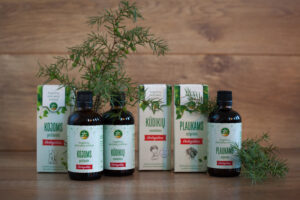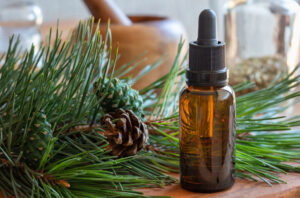Flax is a unique plant, rich with protein, vitamins, trace elements and fibre. The wonderful qualities of linseed were known already to our ancestors, who used to pass down their recipes from generations to generations. The fact that our ancestors knew linseed and widely used it for fabrics and as an important source of nutrition in lack of meat also reflects on archaeological research.
Linseeds are brownish yellow, glossy, smooth and have no smell. They contain up to 48 % of oils and up to 12 % of mucus. Linseeds are very rich with nutrients. They contain 26 % of protein, 40 % of fat (oleic, linoleic and linolenic acid, stearin and palmitic fatty acid glycerides (30-40 %); glycosde linamarin (1.5 %), mucus (5–12 %), protein substances (18–33 %), vitamin C, organic acids, ferments), 22 % carbohydrates, 8 % fibre, 4 % ash. Linseed proteins contain all of the amino acids needed for the human body.
Non heat-treated seeds can be used for food too. Then the proteins are more active and the body absorbs them more easily. Compared to legumes, linseeds contain twice as much oils, 30 % more bioactive fats and 1.7 times more carbohydrates. Linseeds are usually used for food ground, making a fragrant porridge. Ground linseeds have a larger surface to contact with the gastric juice and thus making it easier for the body to absorb all of the beneficial substances. Such mixture can be used to spice up various dishes without having to change the recipe, but it’s best to put it in food at the end of cooking or right before serving. Linseed improves the taste of food and increases its nutritional value. Ground linseed can be used to make tasty halva, kissel or bake bread, also for salads, first and second courses. Moreover, linseeds are used for oil of a very distinct scent.
Flax is an annual herbaceous plant, blooming in June-July and ripening fruit in July-August.
Medicine uses linseeds (Semina Lini) and linseed oil (Oleum Lini). Linseeds are brownish yellow, glossy, smooth and have no smell. They contain up to 48 % of oils and up to 12 % of mucus.
Just like in other mucous plants (plantain, lime, coltsfoot, althaea), the healing mechanism manifests in the mucous substances forming a film on the gastrointestinal mucosa or wound surface, thus protecting the damaged tissue from external irritants. The mucus also absorbs toxic substances, preventing them from entering blood and poisoning the body.
Linseed infusion is used in cases of gastrointestinal ailments: gastric or duodenal ulcers, colitis, enterocolitis.
Linseeds are also used for producing linseed oil, which contains a lot of unsaturated fatty acids that reduce excess cholesterol in the body.
Folk medicine has known linseeds since the old days. Ground and parboiled seeds used to be applied on skin for softening purposes. Patients with chronic constipation used to drink a glass of linseed tea before bed. The recipe was 1 teaspoon of linseeds into a glass of water. Linseed oil was used to eliminate intestinal parasites, while dried flax extract was a popular treatment for kidney and bladder diseases. Ground and parboiled linseed packs were used for sores in order to quicken their maturation and relieve pain.
Literature
Butkus, V., et. al. Mažieji miško turtai. Vilnius: Mokslas 1987.
Čekauskaitė, L. Gamtos vaistinėlė. Kaunas: Spindulys, 2003.
Kaunienė, V.; Kaunas, E. Vaistingieji augalai. Žinynas. Kaunas: Varpas, 1991.
Obelevičius, K; Petkevičiūtė, S; E. Šeinauskienė, E. Prieskoninių augalų ir jų vartojimo žinynas. Kaunas: Lututė, 2011.
Ragažinskienė, O.; Rimkienė, S.; Sasnauskas, V. Vaistinių augalų enciklopedija. Kaunas: Lututė, 2005.





